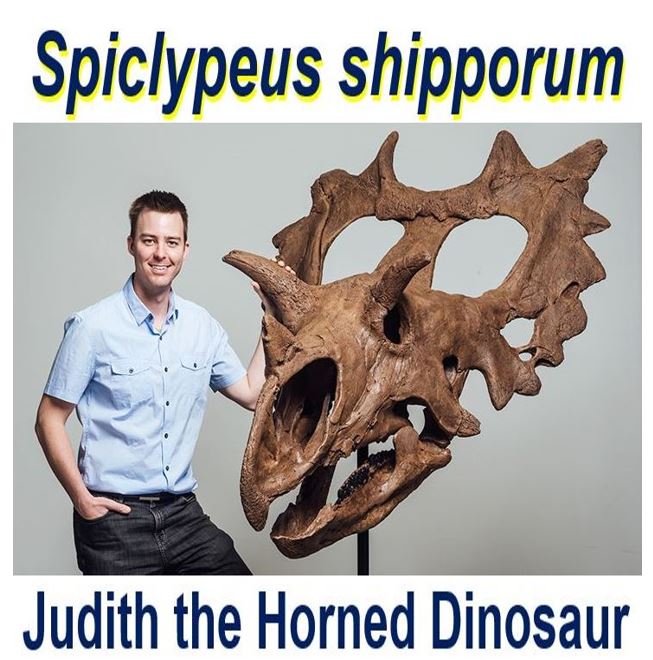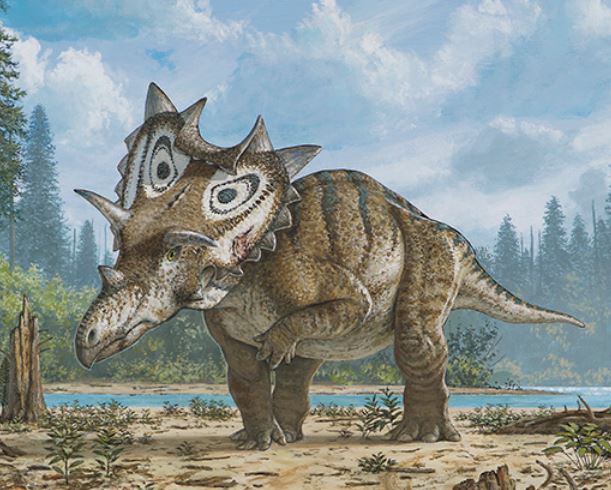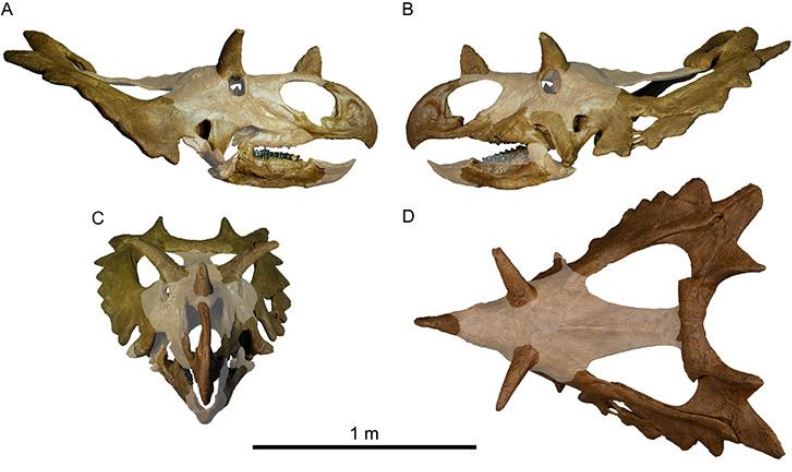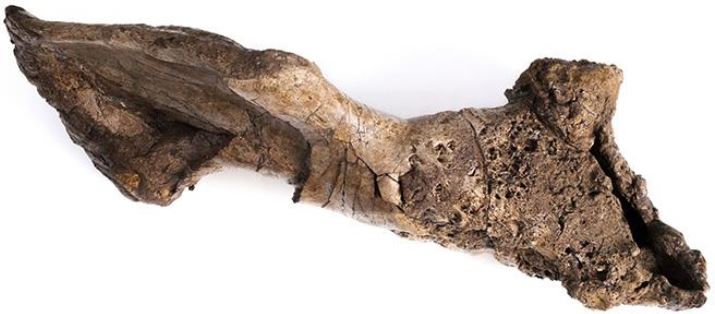Scientists have identified a new species of horned dinosaur, called Judith, following a chance fossil find in the western US state of Montana ten years ago. The fossil was named after the Judith River geological formation where it was discovered.
Scientists from the Canadian Museum of Nature, along with researchers from Canada and the United States, wrote about the herbivorous dinosaur and their findings in the academic journal PLOS ONE (citation below).
The specimen is housed in the Museum’s national fossil collection, which has some of the best horned dinosaurs specimens across the globe.
 Dr. Jordan Mallon with the reconstructed skull of Spiclypeus shipporum, known informally as Judith (collection #CMNFV 57081). (Image: Canadian Museum of Nature)
Dr. Jordan Mallon with the reconstructed skull of Spiclypeus shipporum, known informally as Judith (collection #CMNFV 57081). (Image: Canadian Museum of Nature)
Dr. Jordan Mallon, a palaeontologist at the Museum who studies the evolution and ecology of dinosaurs, completed that scientific analysis that eventually concluded that the dinosaur was a new species.
Many horned dinosaurs found in western North America
It is one of many newly-discovered ceratopsids. Ceratopsids are four-legged herbivorous dinosaurs, found mainly in western North America, characterized by elaborate horns, frills, and rows of shearing teeth in the back of the jaw.
Dr. Mallon has given the dinosaur the scientific name Spiclypeus shipporum. Spiclypeus is Latin for ‘spiked shield’, which refers to the elaborate head frill and triangular spikes along its margins. Shipporum honours the owners of the land where the fossil was discovered near Winifred in Montana – the Shipp family.
Parts of the specimen’s backbone, hips and legs, as well as about half its skull had been preserved in the silty hillside that was once part of a prehistoric floodplain.
 An artist’s depiction of Judith, the new horned dinosaur – Spiclypeus shipporum. In this sketch, the animal held its left front leg close to the body, because bearing its weight would have been painful. (Image: Canadian Museum of Nature. Credit: Mike Skrepnick)
An artist’s depiction of Judith, the new horned dinosaur – Spiclypeus shipporum. In this sketch, the animal held its left front leg close to the body, because bearing its weight would have been painful. (Image: Canadian Museum of Nature. Credit: Mike Skrepnick)
Dr. Mallon said:
“This is a spectacular new addition to the family of horned dinosaurs that roamed western North America between 85 and 66 million years ago. It provides new evidence of dinosaur diversity during the Late Cretaceous period from an area that is likely to yield even more discoveries.”
S. shipporum is different from other horned dinosaurs such as the famous Triceratops because of the position of the horns over the eyes – they stick out sideways from its head.
It also has an unusual arrangement of bony spikes that come out of the margin of the frill – while some the spikes project outwards, others curl forward.
Dr. Mallon explained:
“In this sense, Spiclypeus is transitional between more primitive forms in which all the spikes at the back of the frill radiate outward, and those such as Kosmoceratops in which they all curl forward.”
Before the museum bought it last year, the specimen had remained in the official possession of Dr. Bill Shipp, who discovered it while exploring on his property, which he had recently-acquired in 2005 (the specimen was found over 10 years ago).
Dr. Shipp invested money and time excavating and preparing the bones – he was helped by study-authors Peter Larson, from the Black Hills Institute in South Dakota, and Chris Ott, an independent researcher from Wisconsin.
 Dr. Bill Shipp (red shirt), the owner of the land where Judith was unearthed, and colleagues at the fossil site. (Image: Canadian Museum of Nature. Credit: Joe Small)
Dr. Bill Shipp (red shirt), the owner of the land where Judith was unearthed, and colleagues at the fossil site. (Image: Canadian Museum of Nature. Credit: Joe Small)
A nuclear physicist-turned dinosaur enthusiast
Dr. Shipp, a retired nuclear physicist who became interested in dinosaurs after moving to his dinosaur-rich area, said:
“Little did I know that the first time I went fossil hunting I would stumble on a new species. As a scientist, I’m really pleased that the Canadian Museum of Nature has recognized the dinosaur’s value, and that it can now be accessed by researchers around the world.”
Apart from the frill bones and horns that helped identify Judith as a new species, closer inspection of some of its other bones suggests that the animal lived a life with pain.
Judith’s humerus (upper arm bone) has clear signs of arthritis and bone infection (osteomyelitis), according to an analysis carried out by Dr. Edwrd Iuliano, a radiologist from the Kadlec Regional Medical Cener, Richland, Washington.
 Judith’s reconstructed skull. The darker colour indicates the parts of the skull that were unearthed. The skull is 254 cm long × 122 cm wide × 116 cm high. (Image: Canadian Museum of Nature. Credit: Scott Rufolo)
Judith’s reconstructed skull. The darker colour indicates the parts of the skull that were unearthed. The skull is 254 cm long × 122 cm wide × 116 cm high. (Image: Canadian Museum of Nature. Credit: Scott Rufolo)
Dr. Mallon explained:
“If you look near the elbow, you can see great openings that developed to drain an infection. We don’t know how the bone became infected, but we can be sure that it caused the animal great pain for years and probably made its left forelimb useless for walking.”
Despite the pain and health problems, Dr. David Evans, from the Royal Ontario Museum, who carried out an analysis of the annual growth rings inside the animal’s bones, believes it lived to maturity. When it died, it was probably at least ten years old.
The authors note that there are now nine well-known dinosaur species, including the recently-discovered Spiclypeus shipporum. Some can also be found in Alberta, where fossils are much more abundant than Montana.
 Judith’s humerus, or upper arm bone, shows signs of bone infection and arthritis. Its left forelimb was most likely useless for walking. Despite all that pain, the animal probably lived to maturity. (Image: Canadian Museum of Nature. Credit: Martin Lipman)
Judith’s humerus, or upper arm bone, shows signs of bone infection and arthritis. Its left forelimb was most likely useless for walking. Despite all that pain, the animal probably lived to maturity. (Image: Canadian Museum of Nature. Credit: Martin Lipman)
Dr. Mallon said that none of the species shared with the southern states, suggesting that the dinosaurs that existed in western North America seventy-six million years ago were highly localized.
In Dr. Mallon’s previous research, it was shown that such species-rich communities may have been enabled by specializations among plant-eating animals, a phenomenon known as niche partitioning.
On 24th May, the Canadian Museum of Nature will be holding a public exhibit on Spiclypeus shipporum, which will include the dinosaur’s humerus, a reconstruction of its skull, plus other bones from this remarkable fossil find.
The authors made the following comment in an Abstract in the journal:
“The discovery of Spiclypeus adds to the poorly known dinosaur fauna of the Judith River Formation, and suggests faunal turnover within the formation.”
Citation: “Spiclypeus shipporum gen. et sp. nov., a Boldly Audacious New Chasmosaurine Ceratopsid (Dinosauria: Ornithischia) from the Judith River Formation (Upper Cretaceous: Campanian) of Montana, USA,” Jordan C. Mallon,Peter L. Larson, Christopher J. Ott, Edward M. Iuliano and David C. Evans. PLOS ONE 11(5): e0154218. DOI: 10.1371/journal.pone.0154218.
Video – The horned dinosaurs long, hard life
Dr. Mallon talks about Judith, the horned dinosaur, its life with arthritis and bone infections, and how it turned out to be a new species.

